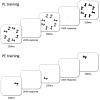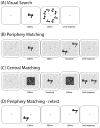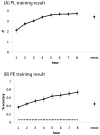Task-irrelevant perceptual expertise
- PMID: 22144562
- PMCID: PMC3351142
- DOI: 10.1167/11.14.3
Task-irrelevant perceptual expertise
Abstract
Perceptual learning (PL) and perceptual expertise (PE) are two fields of visual training studies that investigate how practice improves visual performance. However, previous research suggests that PL can be acquired in a task-irrelevant manner while PE cannot and that PL is highly specific to the training objects and conditions while PE generalizes. These differences are difficult to interpret since PL and PE studies tend to differ on multiple dimensions. We designed a training study with novel objects to compare PL and PE while varying only the training task, such that the training objects, visual field, training duration, and type of learning assessment were kept constant. Manipulations of the training task sufficed to produce the standard effects obtained in PE and PL. In contrast to prior studies, we demonstrated that some degree of PE can be acquired in a task-irrelevant manner, similar to PL. Task-irrelevant PE resulted in similar shape matching ability compared to the directly trained PE. In addition, learning in both PE and PL generalizes to different untrained conditions, which does not support the idea that PE generalizes while PL is specific. Degrees of generalization can be explained by considering the psychological space of the stimuli used for training and the test of transfer.
Figures









Similar articles
-
Prolonged training at threshold promotes robust retinotopic specificity in perceptual learning.J Neurosci. 2014 Jun 18;34(25):8423-31. doi: 10.1523/JNEUROSCI.0745-14.2014. J Neurosci. 2014. PMID: 24948798 Free PMC article. Clinical Trial.
-
Task precision at transfer determines specificity of perceptual learning.J Vis. 2009 Mar 5;9(3):1.1-13. doi: 10.1167/9.3.1. J Vis. 2009. PMID: 19757940 Free PMC article.
-
Nonvisual motor learning improves visual motion perception: evidence from violating the two-thirds power law.J Neurophysiol. 2010 Sep;104(3):1612-24. doi: 10.1152/jn.00974.2009. Epub 2010 Jul 7. J Neurophysiol. 2010. PMID: 20610788 Clinical Trial.
-
Auditory perceptual learning and changes in the conceptualization of auditory cortex.Hear Res. 2018 Sep;366:3-16. doi: 10.1016/j.heares.2018.03.011. Epub 2018 Mar 12. Hear Res. 2018. PMID: 29551308 Review.
-
A unified model for perceptual learning.Trends Cogn Sci. 2005 Jul;9(7):329-34. doi: 10.1016/j.tics.2005.05.010. Trends Cogn Sci. 2005. PMID: 15955722 Review.
Cited by
-
Absolute pitch memory: its prevalence among musicians and dependence on the testing context.Psychon Bull Rev. 2014 Apr;21(2):534-42. doi: 10.3758/s13423-013-0487-z. Psychon Bull Rev. 2014. PMID: 23943554
-
Visual prediction and perceptual expertise.Int J Psychophysiol. 2012 Feb;83(2):156-63. doi: 10.1016/j.ijpsycho.2011.11.002. Epub 2011 Nov 27. Int J Psychophysiol. 2012. PMID: 22123523 Free PMC article. Review.
-
Perceptual expertise with Chinese characters predicts Chinese reading performance among Hong Kong Chinese children with developmental dyslexia.PLoS One. 2021 Jan 22;16(1):e0243440. doi: 10.1371/journal.pone.0243440. eCollection 2021. PLoS One. 2021. PMID: 33481782 Free PMC article.
-
An expert advantage in detecting unfamiliar visual signals in noise.Proc Natl Acad Sci U S A. 2020 Oct 13;117(41):25935-25941. doi: 10.1073/pnas.2003761117. Epub 2020 Sep 30. Proc Natl Acad Sci U S A. 2020. PMID: 32999072 Free PMC article.
-
The nature of experience determines object representations in the visual system.J Exp Psychol Gen. 2012 Nov;141(4):682-98. doi: 10.1037/a0027822. Epub 2012 Apr 2. J Exp Psychol Gen. 2012. PMID: 22468668 Free PMC article.
References
-
- Ahissar M, Hochstein S. Task difficulty and the specificity of perceptual learning. Nature. 1997;387(6631):401–406. - PubMed
-
- Ball K, Sekuler R. Direction-specific improvement in motion discrimination. Vision Res. 1987;27(6):953–965. - PubMed
-
- Brainard DH. The psychophysics toolbox. Spatial Vision. 1997;10:433–436. - PubMed
-
- Bukach CM, Gauthier I, Tarr MJ. Beyond faces and modularity: the power of an expertise framework. Trends Cogn Sci. 2006;10(4):159–166. - PubMed
-
- Fahle M. Specificity of learning curvature, orientation, and vernier discriminations. Vision Res. 1997;37(14):1885–1895. - PubMed
Publication types
MeSH terms
Grants and funding
LinkOut - more resources
Full Text Sources

